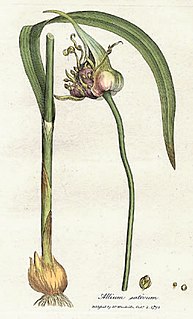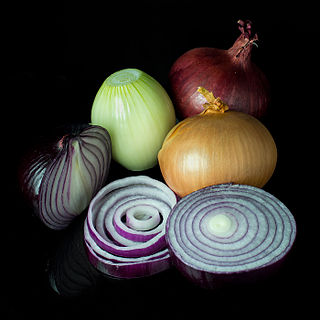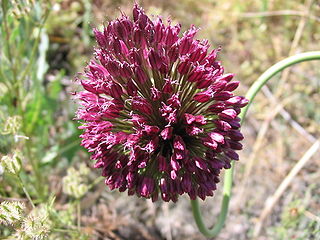
Chives, scientific name Allium schoenoprasum, is a species of flowering plant in the family Amaryllidaceae that produces edible leaves and flowers. Their close relatives include the common onions, garlic, shallot, leek, scallion, and Chinese onion.

Trout are species of freshwater fish belonging to the genera Oncorhynchus, Salmo and Salvelinus, all of the subfamily Salmoninae of the family Salmonidae. The word trout is also used as part of the name of some non-salmonid fish such as Cynoscion nebulosus, the spotted seatrout or speckled trout.

Garlic is a species of bulbous flowering plant in the genus Allium. Its close relatives include the onion, shallot, leek, chive, Welsh onion and Chinese onion. It is native to Central Asia and northeastern Iran and has long been used as a seasoning worldwide, with a history of several thousand years of human consumption and use. It was known to ancient Egyptians and has been used as both a food flavoring and a traditional medicine. China produces 76% of the world's supply of garlic.

The onion, also known as the bulb onion or common onion, is a vegetable that is the most widely cultivated species of the genus Allium. The shallot is a botanical variety of the onion which was classified as a separate species until 2010. Its close relatives include garlic, scallion, leek, and chive.

In botany, a bulb is structurally a short stem with fleshy leaves or leaf bases that function as food storage organs during dormancy.

The rainbow trout is a trout and species of salmonid native to cold-water tributaries of the Pacific Ocean in Asia and North America. The steelhead is an anadromous (sea-run) form of the coastal rainbow trout(O. m. irideus) or Columbia River redband trout (O. m. gairdneri) that usually returns to fresh water to spawn after living two to three years in the ocean. Freshwater forms that have been introduced into the Great Lakes and migrate into tributaries to spawn are also called steelhead.

The Californiagolden trout (Oncorhynchus aguabonita or Oncorhynchus mykiss aguabonita), is a species of trout native to California. The golden trout is normally found in the Golden Trout Creek, Volcano Creek, and the South Fork Kern River. The Golden trout is the official freshwater state fish of California since 1947.

Allium vineale is a perennial, bulb-forming species of wild onion, native to Europe, northwestern Africa and the Middle East. The species was introduced in Australia and North America, where it has become a noxious weed.

Allium canadense, the Canada onion, Canadian garlic, wild garlic, meadow garlic and wild onion is a perennial plant native to eastern North America from Texas to Florida to New Brunswick to Montana. The species is also cultivated in other regions as an ornamental and as a garden culinary herb. The plant is also reportedly naturalized in Cuba.

The sand leek, also known as rocambole and Korean pickled-peel garlic, is a Eurasian species of wild onion with a native range extending across much of Europe, Middle East, and Korea. The species should not be confused with rocambole garlic, which is A. sativum var. ophioscorodon.

Allium sphaerocephalon is a plant species in the Amaryllis family known as round-headed leek, round-headed garlic, ball-head onion, and other variations on these names. Drumstick allium is another common name applied to this species. Some publications use the alternate spelling Allium sphaerocephalum. It is a bulbous herbaceous perennial plant.

Solo garlic, also known as single clove garlic, monobulb garlic, single bulb garlic, or pearl garlic, is a type of Allium sativum (garlic). The size of the single clove differs from approximately 25 to 50 mm in diameter. It has the flavour of the garlic clove but is somewhat milder and slightly perfumed. The appearance is somewhat akin to that of a pickling onion, with white skin and often purple stripes. Solo garlic offers the advantage, compared to traditional garlic, of being very quick and easy to peel.
Aeromonas veronii is a Gram-negative, rod-shaped bacterium found in fresh water and in association with animals. It can be a pathogen of humans and a beneficial symbiont of leeches. In humans A. veronii can cause diseases ranging from wound infections and diarrhea to sepsis in immunocompromised patients. Humans treated with medicinal leeches after vascular surgery can be at risk for infection from A. veronii and are commonly placed on prophylactic antibiotics. Most commonly ciprofloxacin is used but there have been reports of resistant strains leading to infection. In leeches, this bacterium is thought to function in the digestion of blood, provision of nutrients, or preventing other bacteria from growing.

The leek moth or onion leaf miner is a species of moth of family Acrolepiidae and the genus Acrolepiopsis. The species is native to Europe and Siberia, but is also found in North America, where it is an invasive species. While it was initially recorded in Hawaii, this was actually a misidentification of Acrolepiopsis sapporensis.

Allium flavum, the small yellow onion or yellow-flowered garlic, is a species of flowering plant in the genus Allium. A bulbous herbaceous perennial, it is native to the lands surrounding the Mediterranean, Black, and Caspian Seas, from France + Morocco to Iran + Kazakhstan.

Allium polyanthum, called the many-flowered garlic, is a Mediterranean species of wild onion native to Spain, France, Italy, Morocco, and Tunisia. It is widely cultivated for its edible and potently aromatic bulbs and foliage.

The Little Kern golden trout is a brightly colored subspecies of rainbow trout native to the main stem and tributaries of the Little Kern River in Tulare County, California. Together with the California golden trout and the Kern River rainbow trout, the Little Kern golden trout forms what is sometimes referred to as the "golden trout complex" of the Kern River basin.

Allium ochotense, the Siberian onion, is a primarily East Asian species of wild onion native to northern Japan, Korea, China, and the Russian Far East, as well as on Attu Island in Alaska.
Leek yellow stripe virus (LYSV) belongs to the genus Potyvirus. It was first detected in leek but also infects garlic and onion worldwide. Economically less important Allium spp., such as Allium angulosum, Allium caeruleum, Allium cyathophorum, Allium nutans, Allium scorodoprasum, Allium senescens subsp. montanum were also found to harbor the virus.
Shallot latent virus (SLV), a species of Carlavirus, was first identified in shallots in Netherlands. The virus particle is elongated, 650 nm in length.

















